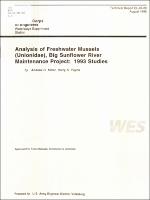Please use this identifier to cite or link to this item:
https://hdl.handle.net/11681/24387| Title: | Analysis of freshwater mussels (Unionidae), Big Sunflower River Maintenance Project : 1993 studies |
| Authors: | Miller, Andrew C. Payne, Barry S. |
| Keywords: | Freshwater mussels--Mississippi--Big Sunflower River Unionidae--Mississippi--Big Sunflower River Dredging--Environmental aspects |
| Publisher: | Environmental Laboratory (U.S.) U.S. Army Engineer Waterways Experiment Station. |
| Series/Report no.: | Technical Report;EL-95-26 |
| Abstract: | A survey to assess community characteristics, density, population demography of dominant species and the presence of rare or endangered species of mussels (Family: Unionidae) was conducted in the Big Sunflower River, September - October 1993. Results will be used to assess the economic value of mussels and to determine the environmental effects of proposed maintenance dredging. Studies were conducted at four beds downriver of Lock and Dam 1 (River Mile (RM) 62 - RM 33.7) and along a river reach upriver of the dam (RM 62.2 - RM 149.2). Downriver of the dam, the substratum at two beds consisted of sand and gravel; one was characterized by clay and sand; and one was composed of silt and sand. Shells of many specimens were eroded and difficult to identify. Upriver of the dam (RM 62.2 - RM 149.2), conditions were more depositional than downriver; fine-grain silt 50 to 70 cm deep was common along the shore. No endangered species were found in the project area, although Pleurobema pyramidatum, which was uncommon in the project area, is a candidate for inclusion on the Federal list of endangered species. At the four beds downriver of the dam, the fauna was dominated by the commercially valuable threeridge (Amblema plicata plicata) (49.1 to 90.0 percent), followed by the pimpleback (Quadrula pustulosa pustulosa) (2.0 to 19.4 percent), and the bankclimber (Plectomerus dombeyanus) (3.5 to 29.0 percent). Species richness at these beds (9 to 12) and species diversity (H', 0.49 to 1.46) were low. Mean density (individuals/square meter) was high and ranged from 28.6 (±2.8, ±Standard Error) to 235.0 (±16.0) and mean biomass (grams/square meter) ranged from 6,590.8 (±636.1) to 52,250.1 (±3,284.8). There was virtually no evidence of recent recruitment for any species; less than 1 percent were less than 30 mm in total length. A greater number of bivalve species (23) were found at depositional sites upriver of abandoned Lock and Dam 1 than downriver of the dam (20). At RM 66.0, Plectomerus dombeyanus dominated (71 percent) shallow water (0.6 m deep) along the shore but was uncommon in the channel (1.8 m deep). In the main channel, Quadrula pustulosa pustulosa (4.8 percent) and Megalonaias nervosa (17 .7 percent) were fairly common, although both were either absent or uncommon in shallow water along the shore. Mean density and collection rate (mussels collected/minute) was 5.5 ± 0.75 and 5.7 ± 0.53 between RM 62.2 and RM 83.0. Between RM 85.2 and RM 149.2, density and collection rate were less than in the lower reach; 2.13 ± 0.71 individuals/square meter and 2.2 ± 0.38 individuals were collected/minute. Marketable sizes of commercially valuable species in the project area have been tentatively established. If the minimum marketable size of the threeridge was 2-5/8 (2.625) in. high (equal to about 94.57 mm long), then approximately 36.0 percent of the population would be harvestable (by fall 1993). Shells of the commercially valuable threeridge have a greater length:height ratio (are more narrow) than specimens from a bed in the upper Mississippi River. If the minimum marketable size of M. nervosa was 3.25 in. high (about 116.4 mm long), then 84.42 percent of the population could be harvested. It was estimated that 1.39 and 1.34 million pounds of threeridge and washboard are marketable. At a price of $1 per pound, these two species would have a total value of approximately $2.7 million dollars. This value considers only specimens, of marketable size in 1994. Maintenance dredging and commercial shell harvest could negatively affect common and uncommon species in the Big Sunflower River. The lack of recent recruitment, dominance of a single species, and low species richness make this community particularly vulnerable. Upriver of the dam, dredging should be restricted to the channel to protect valuable populations along the shore. The beds downriver of the dam could be partially protected by restricting dredging to one bank. Commercial harvest should be carefully regulated and monitored, and selected reaches should be set aside as sanctuaries. The long-term survival of this resource could be ensured by regular monitoring and careful adherence to a well-designed dredging and commercial harvest plan. |
| URI: | http://hdl.handle.net/11681/24387 |
| Appears in Collections: | Technical Report |
Files in This Item:
| File | Description | Size | Format | |
|---|---|---|---|---|
| TR EL-95-26.pdf | 13.8 MB | Adobe PDF |  View/Open |